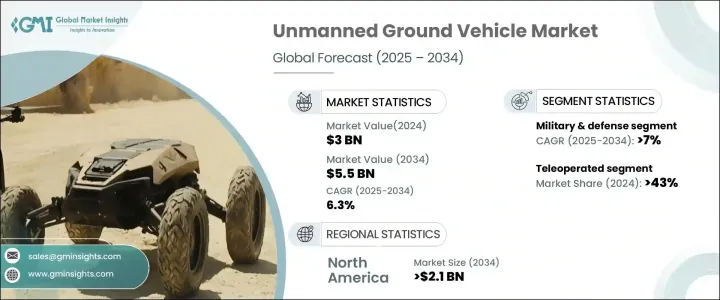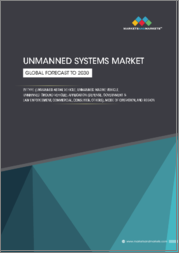
|
시장보고서
상품코드
1684819
무인지상차량(UGV) 시장 기회, 성장 촉진요인, 산업 동향 분석, 예측(2025-2034년)Unmanned Ground Vehicle Market Opportunity, Growth Drivers, Industry Trend Analysis, and Forecast 2025 - 2034 |
||||||
세계의 무인지상차량(UGV) 시장은 2024년 30억 달러로 평가되었으며, 2025년부터 2034년까지 연평균 복합 성장률(CAGR) 6.3%를 나타낼 것으로 보입니다.
UGV는 정찰, 감시, 폭발물 처리 등 위험이 높은 작업을 수행하는데 중요한 역할을 하기 때문에 군 및 방위 활동에 있어서의 자동화 요구의 고조가 이 성장에 박차를 가하고 있습니다. UGV는 정찰, 감시, 폭발물 처리 등 위험한 작업을 수행하는 데 중요한 역할을 하기 때문입니다. 인공지능, 센서 기술 및 머신러닝의 발전은 UGV의 능력을 지속적으로 향상시켜 복잡한 지형에서도 보다 정확하고 자율적인 네비게이션을 가능하게 합니다. 향상된 배터리 성능과 실시간 데이터 처리로 UGV의 운영 범위가 더욱 확대되고 현대 전쟁과 안보 용도에 필수적입니다.

국경 경비, 대 테러리즘, 국토 방위에 대한 주목의 고조는 세계 각국의 정부가 상황 인식과 임무의 유효성을 높이는 최첨단 기술을 우선하는 가운데 UGV의 채용을 가속화하고 있습니다. 방위군은 전투·감시 능력을 강화하기 위해 자율형·원격 조작형 지상 시스템에 대한 투자를 늘리고 있습니다. 또한 UGV는 군사 용도 외에도 광업, 농업, 물류 등의 산업으로 운영의 안전성과 생산성을 향상시키기 위해 이러한 차량을 통합하는 움직임이 확산되고 있습니다. 자동화된 UGV는 위험한 작업을 처리하고 위험한 환경에서의 인간 개입을 줄이고 비용 효율성을 개선하여 산업 프로세스를 간소화합니다. 스마트 네비게이션 시스템의 출현과 장애물 감지 기능의 향상으로 이러한 차량은 여러 부문에 걸친 자율 운영의 미래를 변화시키는 태세를 갖추고 있습니다.
| 시장 범위 | |
|---|---|
| 시작 연도 | 2024년 |
| 예측 연도 | 2025-2034년 |
| 시작 금액 | 30억 달러 |
| 예측 금액 | 55억 달러 |
| CAGR | 6.3% |
2024년 시장 점유율의 43%를 차지한 원격 조작 분야는 계속해서 큰 성장을 이루고 있습니다. 5G 및 위성 연결을 포함한 향상된 통신 기술을 사용하면 방대한 거리를 실시간으로 원격으로 조작할 수 있어 운영자는 UGV를 정확하고 최소한의 대기 시간으로 제어할 수 있습니다. 이러한 진보는 특히 즉각적인 대응과 정확한 조종이 중요한 위험 환경에서 운영 유연성을 크게 향상시킵니다. 방위 분야는 여전히 원격 조작 UGV를 가장 많이 채용하고 있으며, 감시, 정찰, 위협의 무력화에 활용하고 있습니다. 분쟁지대나 재해지역에 원격조작으로 배치할 수 있기 때문에 지속적인 수요가 확보되어 이 분야 시장에서의 우위성이 강화되고 있습니다.
군 및 방위 분야가 무인지상차량(UGV) 시장의 대폭적인 확대를 견인하고 있어 2034년까지의 CAGR은 7%를 나타낼 것으로 예상되고 있습니다. 이러한 차량은 실시간 정보 수집, 자율 항해, 위험물의 자재관리를 필요로 하는 임무를 수행하며, 현대 전투 전략에서 매우 중요한 역할을 하고 있습니다. AI 주도의 의사결정과 고급 네비게이션 알고리즘을 갖춘 UGV는 역동적인 전장 상황에 원활하게 적응하여 운영 효율성을 극대화하면서 위험을 최소화합니다. 방위기관이 전략적 대응 능력을 강화하기 위해 자동화를 우선하는 가운데 차세대 UGV 수요는 계속 증가하고 있습니다.
북미의 무인지상차량(UGV) 시장은 2034년까지 21억 달러를 창출할 것으로 예상되며, 미국이 자율 지상 시스템의 진보를 이끌고 있습니다. AI 주도 군사 솔루션에 대한 방어 투자 증가는 전장 전략을 재구성하고 임무의 정확성과 전술적 의사 결정을 향상시킵니다. 제조업체는 다른 무인 플랫폼과 원활하게 통합되는 상호 운용 가능한 UGV 시스템을 개발하여 임무의 효율성을 최적화합니다. 방위기관의 보유체의 근대화에 따라, 지속적인 기술 혁신과 전략적 자금조달이 시장의 성장을 가속하고, 북미는 차세대 무인 시스템의 중요한 거점으로 자리매김하고 있습니다.
목차
제1장 조사 방법과 조사 범위
- 시장 범위와 정의
- 기본 추정과 계산
- 예측 계산
- 데이터 소스
- 1차 데이터
- 2차 자료
- 유료 정보원
- 공적 정보원
제2장 주요 요약
제3장 업계 인사이트
- 생태계 분석
- 밸류체인에 영향을 주는 요인
- 이익률 분석
- 방해
- 장래의 전망
- 제조업체
- 유통업체
- 공급자의 상황
- 이익률 분석
- 주요 뉴스
- 규제 상황
- 영향요인
- 성장 촉진요인
- 자율기술의 진보
- 국방비 증가와 근대화
- 산업계에 있어서의 자동화 수요 고조
- 지정학적 불안정과 안보 우려의 지속
- 방위와 로봇공학에 대한 정부투자 증가
- 업계의 잠재적 위험 및 과제
- 높은 개발 비용
- 기존 시스템과의 통합
- 성장 촉진요인
- 성장 가능성 분석
- Porter's Five Forces 분석
- PESTEL 분석
제4장 경쟁 구도
- 서론
- 기업 점유율 분석
- 경쟁 포지셔닝 매트릭스
- 전략 전망 매트릭스
제5장 시장 규모 추계·예측 : 사이즈별(2021-2034년)
- 주요 동향
- 소형(20파운드-400파운드)
- 중형(401파운드-2,500파운드)
- 대형(2,501파운드-20,000파운드)
- 초대형(20,000파운드 이상)
제6장 시장 추계·예측 : 모빌리티별(2021-2034년)
- 주요 동향
- 바퀴식
- 추적형
- 다리식
- 하이브리드
제7장 시장 추계·예측 : 시스템별(2021-2034년)
- 주요 동향
- 페이로드
- 네비게이션 시스템
- 컨트롤러 시스템
- 전력 시스템
- 기타
제8장 시장 추계·예측 : 동작 모드별(2021-2034년)
- 주요 동향
- 자율
- 원격 운영
- 테더링
제9장 시장 추계·예측 : 용도별(2021-2034년)
- 주요 동향
- 군 및 방위
- 수색 및 구조(SAR)
- 특수 임무
- 전투 지원
- 폭발물 처리(EOD) 시스템
- 기타
- 상업
- 소방
- 석유 및 가스
- 농업
- 기타
제10장 시장 추계·예측 : 지역별(2021-2034년)
- 주요 동향
- 북미
- 미국
- 캐나다
- 유럽
- 영국
- 독일
- 프랑스
- 이탈리아
- 스페인
- 러시아
- 아시아태평양
- 중국
- 인도
- 일본
- 한국
- 호주
- 라틴아메리카
- 브라질
- 멕시코
- 중동 및 아프리카
- 남아프리카
- 사우디아라비아
- 아랍에미리트(UAE)
제11장 기업 프로파일
- Aselsan
- BAE Systems
- ECA Group
- Elbit Systems
- General Dynamics
- Hexagon
- Israel Aerospace Industries
- L3Harris
- Lockheed Martin
- Northrop Grumman
- QinetiQ
- Rheinmetall
- ST Engineering
- Teledyne
- Textron
- Thales
The Global Unmanned Ground Vehicle Market, valued at USD 3 billion in 2024, is set to expand at a CAGR of 6.3% from 2025 to 2034. The increasing need for automation in military and defense operations is fueling this growth as UGVs play a vital role in executing high-risk tasks, including reconnaissance, surveillance, and explosive ordnance disposal. By reducing threats to human personnel, these vehicles enhance mission efficiency and operational safety. Advances in artificial intelligence, sensor technology, and machine learning continue to improve UGV capabilities, enabling more precise and autonomous navigation across complex terrains. Enhanced battery performance and real-time data processing further extend their operational range, making them indispensable in modern warfare and security applications.

The growing focus on border security, counterterrorism, and homeland defense accelerates the adoption of UGVs as governments worldwide prioritize cutting-edge technologies that enhance situational awareness and mission effectiveness. Defense forces are increasingly investing in autonomous and remotely operated ground systems to bolster combat and surveillance capabilities. Additionally, UGVs are gaining traction beyond military applications, with industries such as mining, agriculture, and logistics integrating these vehicles to improve operational safety and productivity. Automated UGVs streamline industrial processes by handling hazardous tasks, reducing human intervention in dangerous environments, and improving cost efficiency. With the emergence of smart navigation systems and improved obstacle detection, these vehicles are poised to transform the future of autonomous operations across multiple sectors.
| Market Scope | |
|---|---|
| Start Year | 2024 |
| Forecast Year | 2025-2034 |
| Start Value | $3 billion |
| Forecast Value | $5.5 billion |
| CAGR | 6.3% |
The teleoperated segment, which accounted for 43% of the market share in 2024, continues to witness substantial growth. Enhanced communication technologies, including 5G and satellite connectivity, enable real-time remote operation across vast distances, allowing operators to control UGVs with precision and minimal latency. These advancements significantly enhance operational flexibility, particularly in hazardous environments where immediate response and accurate maneuvering are crucial. The defense sector remains the largest adopter of teleoperated UGVs, utilizing them for surveillance, reconnaissance, and threat neutralization. Their ability to be deployed remotely in conflict zones or disaster-stricken areas ensures continuous demand, reinforcing the segment's dominance in the market.
The military and defense sector drives significant expansion in the UGV market, with an expected CAGR of 7% through 2034. These vehicles play a pivotal role in modern combat strategies, executing missions that require real-time intelligence gathering, autonomous navigation, and hazardous material handling. Equipped with AI-driven decision-making and advanced navigation algorithms, UGVs seamlessly adapt to dynamic battlefield conditions, minimizing risks while maximizing operational efficiency. As defense agencies prioritize automation to enhance strategic response capabilities, the demand for next-generation UGVs continues to rise.
North America UGV market is projected to generate USD 2.1 billion by 2034, with the United States leading advancements in autonomous ground systems. Rising defense investments in AI-driven military solutions are reshaping battlefield strategies, thus improving mission precision and tactical decision-making. Manufacturers are developing interoperable UGV systems that integrate seamlessly with other unmanned platforms, optimizing mission effectiveness. As defense agencies modernize their fleets, continuous innovation and strategic funding drive market growth, positioning North America as a key hub for next-generation unmanned systems.
Table of Contents
Chapter 1 Methodology & Scope
- 1.1 Market scope & definitions
- 1.2 Base estimates & calculations
- 1.3 Forecast calculations
- 1.4 Data sources
- 1.4.1 Primary
- 1.4.2 Secondary
- 1.4.2.1 Paid sources
- 1.4.2.2 Public sources
Chapter 2 Executive Summary
- 2.1 Industry synopsis, 2021-2034
Chapter 3 Industry Insights
- 3.1 Industry ecosystem analysis
- 3.1.1 Factor affecting the value chain
- 3.1.2 Profit margin analysis
- 3.1.3 Disruptions
- 3.1.4 Future outlook
- 3.1.5 Manufacturers
- 3.1.6 Distributors
- 3.2 Supplier landscape
- 3.3 Profit margin analysis
- 3.4 Key news & initiatives
- 3.5 Regulatory landscape
- 3.6 Impact forces
- 3.6.1 Growth drivers
- 3.6.1.1 Advancements in autonomous technologies
- 3.6.1.2 Increased defense spending and modernization
- 3.6.1.3 Rising demand for automation in industry
- 3.6.1.4 Ongoing geopolitical instability and security concerns
- 3.6.1.5 Increasing government investments in defense and robotics
- 3.6.2 Industry pitfalls & challenges
- 3.6.2.1 High development costs
- 3.6.2.2 Integration with existing systems
- 3.6.1 Growth drivers
- 3.7 Growth potential analysis
- 3.8 Porter’s analysis
- 3.9 PESTEL analysis
Chapter 4 Competitive Landscape, 2024
- 4.1 Introduction
- 4.2 Company market share analysis
- 4.3 Competitive positioning matrix
- 4.4 Strategic outlook matrix
Chapter 5 Market Estimates & Forecast, By Size, 2021-2034 (USD Million & Units)
- 5.1 Key trends
- 5.2 Small (20lb to 400lb)
- 5.3 Medium (401lb to 2,500lb)
- 5.4 Large (2,501lb to 20,000lb)
- 5.5 Extra-large (Over 20,000lb)
Chapter 6 Market Estimates & Forecast, By Mobility, 2021-2034 (USD Million & Units)
- 6.1 Key trends
- 6.2 Wheeled
- 6.3 Tracked
- 6.4 Legged
- 6.5 Hybrid
Chapter 7 Market Estimates & Forecast, By System, 2021-2034 (USD Million & Units)
- 7.1 Key trends
- 7.2 Payloads
- 7.3 Navigation system
- 7.4 Controller system
- 7.5 Power system
- 7.6 Others
Chapter 8 Market Estimates & Forecast, By Mode of Operation, 2021-2034 (USD Million & Units)
- 8.1 Key trends
- 8.2 Autonomous
- 8.3 Teleoperated
- 8.4 Tethered
Chapter 9 Market Estimates & Forecast, By Application, 2021-2034 (USD Million & Units)
- 9.1 Key trends
- 9.2 Military & defense
- 9.2.1 Search & rescue (SAR)
- 9.2.2 Special mission
- 9.2.3 Combat support
- 9.2.4 Explosive Ordnance Disposal (EOD) System
- 9.2.5 Others
- 9.3 Commercial
- 9.3.1 Fire fighting
- 9.3.2 Oil & gas
- 9.3.3 Agriculture
- 9.3.4 Others
Chapter 10 Market Estimates & Forecast, By Region, 2021-2034 (USD Million & Units)
- 10.1 Key trends
- 10.2 North America
- 10.2.1 U.S.
- 10.2.2 Canada
- 10.3 Europe
- 10.3.1 UK
- 10.3.2 Germany
- 10.3.3 France
- 10.3.4 Italy
- 10.3.5 Spain
- 10.3.6 Russia
- 10.4 Asia Pacific
- 10.4.1 China
- 10.4.2 India
- 10.4.3 Japan
- 10.4.4 South Korea
- 10.4.5 Australia
- 10.5 Latin America
- 10.5.1 Brazil
- 10.5.2 Mexico
- 10.6 MEA
- 10.6.1 South Africa
- 10.6.2 Saudi Arabia
- 10.6.3 UAE
Chapter 11 Company Profiles
- 11.1 Aselsan
- 11.2 BAE Systems
- 11.3 ECA Group
- 11.4 Elbit Systems
- 11.5 General Dynamics
- 11.6 Hexagon
- 11.7 Israel Aerospace Industries
- 11.8 L3Harris
- 11.9 Lockheed Martin
- 11.10 Northrop Grumman
- 11.11 QinetiQ
- 11.12 Rheinmetall
- 11.13 ST Engineering
- 11.14 Teledyne
- 11.15 Textron
- 11.16 Thales



















